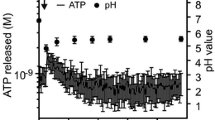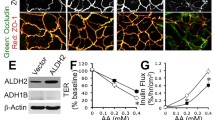Abstract
Extracellular adenosine-5′-triphosphate (ATP) regulates cell death and survival of neighboring cells. The detailed effects are diverse depending on cell types and extracellular ATP concentration. We addressed the effect of ATP on ethanol-induced cytotoxicity in epithelial cells, the cell type that experiences the highest concentrations of alcohol. Using pancreatic duct epithelial cells (PDEC), we found that a micromolar range of ATP reverses all intracellular toxicity mechanisms triggered by exceptionally high doses of ethanol and, thus, improves cell viability dramatically. Out of the many purinergic receptors expressed in PDEC, the P2Y1 receptor was identified to mediate the protective effect, based on pharmacological and siRNA assays. Activation of P2Y1 receptors increased intracellular cyclic adenosine monophosphate (cAMP). The protective effect of ATP was mimicked by forskolin and 8-Br-cAMP but inhibited by a protein kinase A (PKA) inhibitor, H-89. Finally, ATP reverted leakiness of PDEC monolayers induced by ethanol and helped to maintain epithelial integrity. We suggest that purinergic receptors reduce extreme alcohol-induced cell damage via the cAMP signal pathway in PDEC and some other types of cells.














Similar content being viewed by others
Abbreviations
- ADH:
-
Alcohol dehydrogenase
- ALDH:
-
Acetaldehyde dehydrogenase
- FAEE:
-
Fatty acid ethyl ester
- FRET:
-
Fluorescence resonance energy transfer
- GAPDH:
-
Glyceraldehyde-3-phosphate dehydrogenase
- MMP:
-
Mitochondrial membrane potential
- PDEC:
-
Pancreatic duct epithelial cells
- PKA:
-
Protein kinase A
- PKC:
-
Protein kinase C
- P2 receptor:
-
Purinergic type 2 receptor
- PMA:
-
Phorbol 12-myristate 13-acetate
- ROS:
-
Reactive oxygen species
References
Ahn S, Nelson CD, Garrison TR, Miller WE, Lefkowitz RJ. Desensitization, internalization, and signaling functions of beta-arrestins demonstrated by RNA interference. Proc Natl Acad Sci U S A. 2003;100(4):1740–4.
Alfonso-Loeches S, Guerri C. Molecular and behavioral aspects of the actions of alcohol on the adult and developing brain. Crit Rev Clin Lab Sci. 2011;48(1):19–47.
Anccasi RM, Ornelas IM, Cossenza M, Persechini PM, Ventura AL. ATP induces the death of developing avian retinal neurons in culture via activation of P2X7 and glutamate receptors. Purinergic Signal. 2013;9(1):15–29.
Arthur DB, Georgi S, Akassoglou K, Insel PA. Inhibition of apoptosis by P2Y2 receptor activation: novel pathways for neuronal survival. J Neurosci. 2006;26(14):3798–804.
Blanco-Aparicio C, Molina MA, Fernandez-Salas E, Frazier ML, Mas JM, Querol E, et al. Potato carboxypeptidase inhibitor, a T-knot protein, is an epidermal growth factor antagonist that inhibits tumor cell growth. J Biol Chem. 1998;273(20):12370–7.
Bujanda L. The effects of alcohol consumption upon the gastrointestinal tract. Am J Gastroenterol. 2000;95(12):3374–82.
Burnstock G. Pathophysiology and therapeutic potential of purinergic signaling. Pharmacol Rev. 2006;58(1):58–86.
Burnstock G, Arnett TR, Orriss IR. Purinergic signalling in the musculoskeletal system. Purinergic Signal. 2013;9(4):541–72.
Buvinic S, Bravo-Zehnder M, Boyer JL, Huidobro-Toro JP, Gonzalez A. Nucleotide P2Y1 receptor regulates EGF receptor mitogenic signaling and expression in epithelial cells. J Cell Sci. 2007;120(Pt 24):4289–301.
Chen CC, Liou SW, Chen CC, Chen WC, Hu FR, Wang IJ, et al. Coenzyme Q10 reduces ethanol-induced apoptosis in corneal fibroblasts. PLoS One. 2011;6(4), e19111.
Chen HH, Schock SC, Xu J, Safarpour F, Thompson CS, Stewart AF. Extracellular ATP-dependent upregulation of the transcription cofactor LMO4 promotes neuron survival from hypoxia. Exp Cell Res. 2007;313(14):3106–16.
Coutinho-Silva R, Stahl L, Cheung KK, de Campos NE, de Oliveira Souza C, Ojcius DM, et al. P2X and P2Y purinergic receptors on human intestinal epithelial carcinoma cells: effects of extracellular nucleotides on apoptosis and cell proliferation. Am J Physiol Gastrointest Liver Physiol. 2005;288(5):G1024–35.
Das Kumar S, Vasudevan DM. Alcohol induced effects on kidney. Indian J Clin Biochem. 2008;23(1):4–9.
Elliott MR, Chekeni FB, Trampont PC, Lazarowski ER, Kadl A, Walk SF, et al. Nucleotides released by apoptotic cells act as a find-me signal to promote phagocytic clearance. Nature. 2009;461(7261):282–6.
Forster D, Reiser G. Nucleotides protect rat brain astrocytes against hydrogen peroxide toxicity and induce antioxidant defense via P2Y receptors. Neurochem Int. 2016;94:57–66.
Fredholm BB, Assender JW, Irenius E, Kodama N, Saito N. Synergistic effects of adenosine A1 and P2Y receptor stimulation on calcium mobilization and PKC translocation in DDT1 MF-2 cells. Cell Mol Neurobiol. 2003;23(3):379–400.
Gramenzi A, Caputo F, Biselli M, Kuria F, Loggi E, Andreone P, et al. Review article: alcoholic liver disease—pathophysiological aspects and risk factors. Aliment Pharmacol Ther. 2006;24(8):1151–61.
Guerra L, Favia M, Fanelli T, Calamita G, Svetlo M, Bagorda A, et al. Stimulation of Xenopus P2Y1 receptor activates CFTR in A6 cells. Pflugers Arch. 2004;449(1):66–75.
Halls ML, Cooper DM. Regulation by Ca2 + −signaling pathways of adenylyl cyclases. Cold Spring Harb Perspect Biol. 2011;3(1):a004143.
Hansen MR, Krabbe S, Novak I. Purinergic receptors and calcium signalling in human pancreatic duct cell lines. Cell Physiol Biochem. 2008;22(1–4):157–68.
Harvey MH, Wedgwood KR, Austin JA, Reber HA. Pancreatic duct pressure, duct permeability and acute pancreatitis. Br J Surg. 1989;76(8):859–62.
Huang N, Wang DJ, Heppel LA. Extracellular ATP is a mitogen for 3T3, 3T6, and A431 cells and acts synergistically with other growth factors. Proc Natl Acad Sci U S A. 1989;86(20):7904–8.
Insel PA, Zhang L, Murray F, Yokouchi H, Zambon AC. Cyclic AMP is both a pro-apoptotic and anti-apoptotic second messenger. Acta Physiol (Oxf). 2012;204(2):277–87.
Jung SR, Hille B, Nguyen TD, Koh DS. Cyclic AMP potentiates Ca2 + −dependent exocytosis in pancreatic duct epithelial cells. J Gen Physiol. 2010;135(5):527–43.
Katschinski DM, Boos K, Schindler SG, Fandrey J. Pivotal role of reactive oxygen species as intracellular mediators of hyperthermia-induced apoptosis. J Biol Chem. 2000;275(28):21094–8.
Kong Q, Wang M, Liao Z, Camden JM, Yu S, Simonyi A, et al. P2X7 nucleotide receptors mediate caspase-8/9/3-dependent apoptosis in rat primary cortical neurons. Purinergic Signal. 2005;1(4):337–47.
Kruse M, Hammond GR, Hille B. Regulation of voltage-gated potassium channels by PI(4,5)P2. J Gen Physiol. 2012;140(2):189–205.
Lee JH, Nguyen KH, Mishra S, Nyomba BL. Prohibitin is expressed in pancreatic beta-cells and protects against oxidative and proapoptotic effects of ethanol. FEBS J. 2010;277(2):488–500.
Logue SE, Elgendy M, Martin SJ. Expression, purification and use of recombinant annexin V for the detection of apoptotic cells. Nat Protoc. 2009;4(9):1383–95.
Mamedova LK, Gao ZG, Jacobson KA. Regulation of death and survival in astrocytes by ADP activating P2Y1 and P2Y12 receptors. Biochem Pharmacol. 2006;72(8):1031–41.
Miller CM, Boulter NR, Fuller SJ, Zakrzewski AM, Lees MP, Saunders BM, et al. The role of the P2X7 receptor in infectious diseases. PLoS Pathog. 2011;7(11), e1002212.
Moore MS, DeZazzo J, Luk AY, Tully T, Singh CM, Heberlein U. Ethanol intoxication in Drosophila: genetic and pharmacological evidence for regulation by the cAMP signaling pathway. Cell. 1998;93(6):997–1007.
Nikolaev VO, Bunemann M, Hein L, Hannawacker A, Lohse MJ. Novel single chain cAMP sensors for receptor-induced signal propagation. J Biol Chem. 2004;279(36):37215–8.
Noguchi T, Ishii K, Fukutomi H, Naguro I, Matsuzawa A, Takeda K, et al. Requirement of reactive oxygen species-dependent activation of ASK1-p38 MAPK pathway for extracellular ATP-induced apoptosis in macrophage. J Biol Chem. 2008;283(12):7657–65.
Oda D, Savard CE, Eng L, Lee SP. The effect of N-methyl-N’-nitro-N-nitrosoguanidine (MNNG) on cultured dog pancreatic duct epithelial cells. Pancreas. 1996a;12(2):109–16.
Oda D, Savard CE, Nguyen TD, Eng L, Swenson ER, Lee SP. Dog pancreatic duct epithelial cells: long-term culture and characterization. Am J Pathol. 1996b;148(3):977–85.
Olney JW, Tenkova T, Dikranian K, Muglia LJ, Jermakowicz WJ, D’Sa C, et al. Ethanol-induced caspase-3 activation in the in vivo developing mouse brain. Neurobiol Dis. 2002;9(2):205–19.
Palaga T, Kataoka T, Nagai K. Extracellular ATP inhibits apoptosis and maintains cell viability by inducing autocrine production of interleukin-4 in a myeloid progenitor cell line. Int Immunopharmacol. 2004;4(7):953–61.
Palombo JD, Pomposelli JJ, Fechner KD, Blackburn GL, Bistrian BR. Enhanced restoration of adenine nucleotides in rat liver following extended preservation in UW solution by provision of adenosine during reperfusion. Transplantation. 1991;51(4):867–73.
Park DW, Cho T, Kim MR, Kim YA, Min CK, Hwang KJ. ATP-induced apoptosis of human granulosa luteal cells cultured in vitro. Fertil Steril. 2003;80(4):993–1002.
Placido R, Auricchio G, Falzoni S, Battistini L, Colizzi V, Brunetti E, et al. P2X7 purinergic receptors and extracellular ATP mediate apoptosis of human monocytes/macrophages infected with Mycobacterium tuberculosis reducing the intracellular bacterial viability. Cell Immunol. 2006;244(1):10–8.
Pourzand C, Tyrrell RM. Apoptosis, the role of oxidative stress and the example of solar UV radiation. Photochem Photobiol. 1999;70(4):380–90.
Rabbani M, Tabakoff B. Chronic ethanol treatment reduces adenylyl cyclase activity in human erythroleukemia cells. Eur J Pharmacol. 2001;430(1):19–23.
Ramachandran V, Watts LT, Maffi SK, Chen J, Schenker S, Henderson G. Ethanol-induced oxidative stress precedes mitochondrially mediated apoptotic death of cultured fetal cortical neurons. J Neurosci Res. 2003;74(4):577–88.
Rotoli BM, Orlandini G, Guizzardi S, Uggeri J, Dall’Asta V, Gazzola GC, et al. Ethanol increases the paracellular permeability of monolayers of CAPAN-1 pancreatic duct cells. J Mol Histol. 2004;35(4):355–62.
Schmid-Schonbein GW, Hugli TE. A new hypothesis for microvascular inflammation in shock and multiorgan failure: self-digestion by pancreatic enzymes. Microcirculation. 2005;12(1):71–82.
Seo JB, Gowda GAN, Koh DS. Apoptotic damage of pancreatic ductal epithelia by alcohol and its rescue by an antioxidant. PLoS One. 2013;8(11), e81893.
Shinozaki Y, Koizumi S, Ishida S, Sawada J, Ohno Y, Inoue K. Cytoprotection against oxidative stress-induced damage of astrocytes by extracellular ATP via P2Y1 receptors. Glia. 2005;49(2):288–300.
Souza CO, Santoro GF, Figliuolo VR, Nanini HF, de Souza HS, Castelo-Branco MT, et al. Extracellular ATP induces cell death in human intestinal epithelial cells. Biochim Biophys Acta. 2012;1820(12):1867–78.
Steward MC, Ishiguro H, Case RM. Mechanisms of bicarbonate secretion in the pancreatic duct. Annu Rev Physiol. 2005;67:377–409.
Sun AY, Chen YM. Extracellular ATP-induced apoptosis in PC12 cells. Adv Exp Med Biol. 1998;446:73–83.
Tonazzini I, Trincavelli ML, Montali M, Martini C. Regulation of A1 adenosine receptor functioning induced by P2Y1 purinergic receptor activation in human astroglial cells. J Neurosci Res. 2008;86(13):2857–66.
Urban D, Hartel FV, Gadiraju K, Gunduz D, Aslam M, Piper HM, et al. Extracellular ATP attenuates ischemia-induced caspase-3 cleavage in human endothelial cells. Biochem Biophys Res Commun. 2012;425(2):230–6.
Wei Q, Costanzi S, Liu QZ, Gao ZG, Jacobson KA. Activation of the P2Y1 receptor induces apoptosis and inhibits proliferation of prostate cancer cells. Biochem Pharmacol. 2011;82(4):418–25.
Wijeratne SS, Cuppett SL, Schlegel V. Hydrogen peroxide induced oxidative stress damage and antioxidant enzyme response in Caco-2 human colon cells. J Agric Food Chem. 2005;53(22):8768–74.
Willoughby D, Cooper DM. Organization and Ca2+ regulation of adenylyl cyclases in cAMP microdomains. Physiol Rev. 2007;87(3):965–1010.
Wilson JS, Apte MV. Role of alcohol metabolism in alcoholic pancreatitis. Pancreas. 2003;27(4):311–5.
Yoon MJ, Lee HJ, Kim JH, Kim DK. Extracellular ATP induces apoptotic signaling in human monocyte leukemic cells, HL-60 and F-36P. Arch Pharm Res. 2006;29(11):1032–41.
Yoshioka K, Hosoda R, Kuroda Y, Nakata H. Hetero-oligomerization of adenosine A1 receptors with P2Y1 receptors in rat brains. FEBS Lett. 2002;531(2):299–303.
Yoshioka K, Nakata H. ATP- and adenosine-mediated signaling in the central nervous system: purinergic receptor complex: generating adenine nucleotide-sensitive adenosine receptors. J Pharmacol Sci. 2004;94(2):88–94.
Zakhari S. Overview: how is alcohol metabolized by the body? Alcohol Res Health. 2006;29(4):245–54.
Zhang Z, Wang Z, Ren H, Yue M, Huang K, Gu H, et al. P2Y6 agonist uridine 5'-diphosphate promotes host defense against bacterial infection via monocyte chemoattractant protein-1-mediated monocytes/macrophages recruitment. J Immunol. 2011;186(9):5376–87.
Acknowledgments
We thank Mark Moody and Lea M. Miller for technical assistance; Drs. Eamonn J. Dickson, and Toan N. Nguyen for helpful discussion and reading of manuscript: and Drs. Martin Kruse, Oscar Vivas, Haijie Yu, Po-Ni Lai, and Sei-Hum Jang for comments and helpful discussion. This work was supported by National Institutes of Health grant (R01-DK080840 to D.S.K.).
Author contributions
J.B.S., S.R.J., B.H., and D.S.K. developed the concept and designed research; J.B.S. and S.R.J. performed the experiments; J.B.S., S.R.J., and D.S.K. analyzed data; J.B.S., S.R.J., B.H., and D.S.K. interpreted results of experiments; J.B.S. and S.R.J. prepared figures; J.B.S. drafted manuscript; and J.B.S., S.R.J., B.H., and D.S.K. edited manuscript.
Author information
Authors and Affiliations
Corresponding author
Ethics declarations
Conflict of interest
The authors declare that they have no competing interests
Rights and permissions
About this article
Cite this article
Seo, J.B., Jung, SR., Hille, B. et al. Extracellular ATP protects pancreatic duct epithelial cells from alcohol-induced damage through P2Y1 receptor-cAMP signal pathway. Cell Biol Toxicol 32, 229–247 (2016). https://doi.org/10.1007/s10565-016-9331-3
Received:
Accepted:
Published:
Issue Date:
DOI: https://doi.org/10.1007/s10565-016-9331-3




